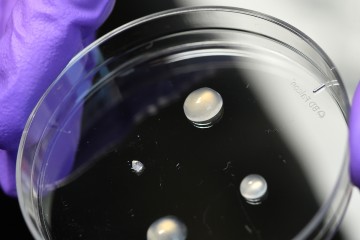Nobody likes pimples, particularly when we consider that those nasty-looking blemishes are caused by swarms of bacteria on our skin.
Three Johns Hopkins University undergraduates have designed a new face cream, called "No Inhibitions," that takes a clever new approach to keeping those bacteria under control.
The team of chemical and biomolecular engineering majors started by pinpointing a key trigger of an acne outbreak: a substance secreted by the bacterium P. acnes that converts face oil into free fatty acids, which activate the immune system and cause inflammation.
Most anti-acne products work either by killing P. acnes or slowing production of the oily stuff, called sebum, that the bacteria like to eat. Using an over-the-counter weight-loss drug as their foundation, the team designed a product that takes a different tack: interrupting the zit-causing conversion of sebum into fatty acids.
"The weight-loss drug prevents your body from absorbing nutrients and fat from the foods you're eating. We're trying to do basically the same thing, except on your face," said Anna Garcia, one of the students who worked on the project. "The big difference with our product is that we're not trying to kill P. acnes, but to regulate its growth."
Lipase, an enzyme from the bacteria, helps break down sebum into fatty acids and alcohols. When the student team researched lipase inhibitors, the weight-loss drug jumped to the top of the list of options. The trio spent nearly a year honing their design. It took three trials before they saw the results they hoped to see.
"We felt confident in our theory, so we knew if it wasn't working, we probably just needed to change something," said Joan Golding, another member of the student team.
The "No Inhibitions" team—whose work was guided by Marc Donohue, a professor of chemical and biomolecular engineering—presented its project during the school's annual Design Day on May 8 along with dozens of other Whiting School of Engineering students.
Projects created in their engineering design class must be novel enough to undergo the patent application process, so the "No Inhibitions" team members added components like tea tree oil and Omega 3s to reduce inflammation.
"Theirs is one of the more innovative projects I have seen in the last decade, and there's a chance it could be successful in the marketplace," Donohue said. "There's nothing on the market like it. Most acne treatments work by trying to kill bacteria rather than looking at the cause of the acne itself."
Besides a recipe for a new pimple-fighter, the team members said they are leaving the experience with a new perspective on the process of discovery.
"Part of this was realizing that adults have to figure stuff out, too," Ariana Sherman said. "I feel more confident now going into a workplace, because I know I don't have to know everything up front."
Posted in Health, Science+Technology
Tagged chemical engineering, biomolecular engineering, design days, beauty









